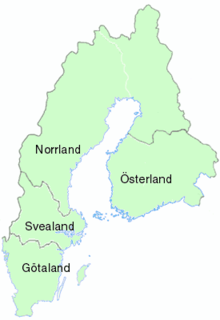Part of the country (Sweden)
The large regions of Norrland , Svealand and Götaland are referred to as Landsdel ('Landesteil'. Pl. Landsdelar ) in Sweden .
In today's Sweden, the division into parts of the country is of marginal interest. They are mainly used in meteorology and statistics . The parts of the country have no political or administrative significance, as do the culturally very important landscapes ( landskap ). Such functions are taken over by the provinces ( län ) as state authorities and by the communal associations (Landsting), which are geographically identical to the provinces.
In the EU statistics, Sweden is not divided into 3 parts of the country, but into 3 groups of territories, the boundaries of which differ greatly (see NUTS: SE ).
| Part of the country | Residents 2011 |
km² | Number of landscapes |
Landscapes |
|---|---|---|---|---|
| Götaland | 4,543,533 | 97.841 | 10 | Skåne , Blekinge , Halland , Småland , Öland , Gotland , Östergötland , Västergötland , Dalsland and Bohuslän |
| Svealand | 3,785,534 | 91,098 | 6th | Södermanland , Uppland , Västmanland , Närke , Värmland , Dalarna |
| Norrland | 1,153,788 | 261.292 | 9 | Gästrikland , Hälsingland , Härjedalen , Jämtland , Medelpad , Ångermanland , Västerbotten , Norrbotten and Lapland |
Österland as the fourth part of the country
Finland was part of Sweden until 1809 . The northern part of today's Finland was counted as part of Norrland, the Åland Islands as part of Svealand, and the south with Österland formed a separate part of the country.
See also
Individual evidence
- ↑ Population by parts of the country, regions and provinces. Statistiska centralbyrån; accessed June 1, 2012

